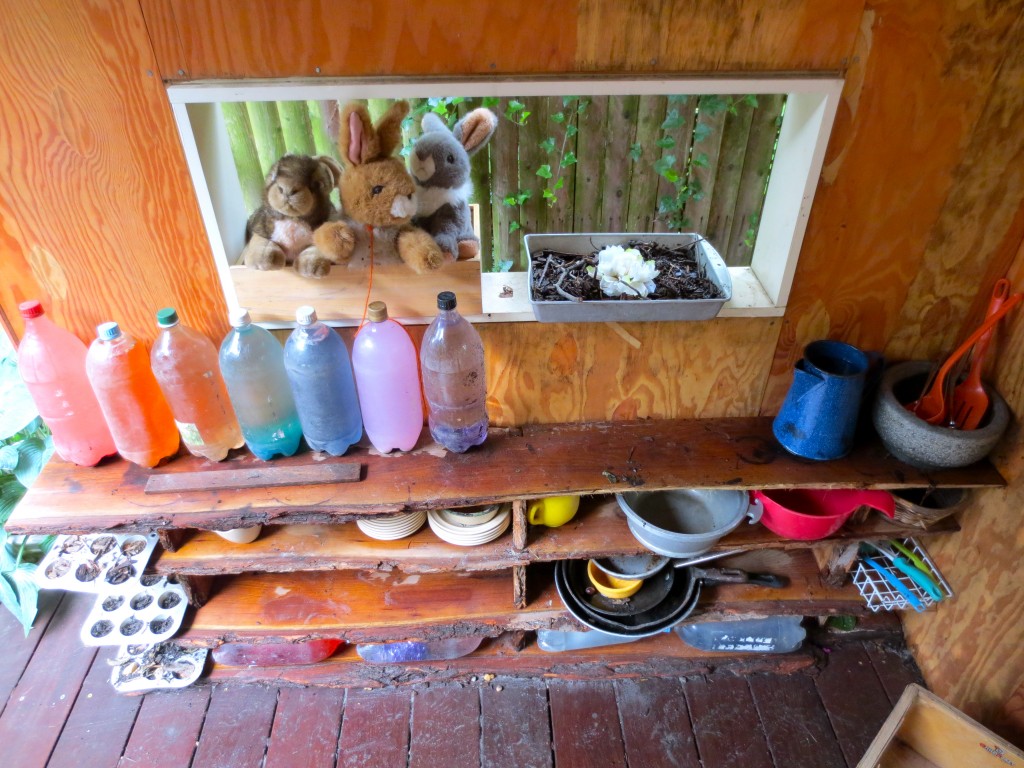"That is not the teahouse, that is a flower house"
This is what one of the older boys said to me as he stood on the seesaw, surfing, rocking back and forth. He was watching a group of older girls work through the open window of what was, as of this morning, the Children's Teahouse. I had just walked in to the yard and my arms were loaded down with unfinished paperwork from the school year. I stopped near where this boy was doing his balancing act-running commentary to get a good look around at how Tink children were using the yard. Much better than going inside to deal with paperwork, for sure.
Even though I could see some interesting things going on in the very back (rope wrangling and tire swing experiments, specifically), I didn't go any farther. I stopped to see what he was talking about for two reasons. First, he delivered this sentence in such a droll way. It was as if he knew someone would be coming around the corner and they would certainly be wondering what was going on inside the teahouse. Secondly, I realized that this name change meant something significant to him -- the Children's Teahouse was kind of his and his classmates'. They had broken the ground for its foundation in 2011 when they were 4 and a half and 5-years old. They used their little plastic shovels and scraped away a large square of wood chips and dirt, carrying it wheelbarrow by wheelbarrow and spreading it on the berm in the very back. They brought in the gravel that still sits beneath the structure and were the first to play inside it once it was built. He watched the new players, removed but very much paying attention to each added detail of their play, and their new-fangled name designation. "These flower people," I imagined him thinking, "they just don't know."
The thing about #Tink that I love is that the children get to come back to a beloved space -- whether they went to nursery school with us or are tink regulars -- to play. Even the first-timers, instantly figure it out. The space makes sense to them. This is no accident, it is quite purposeful, many of the changes that have taken place in our yard have been inspired by watching how older children use it and then the changes are simply enjoyed for longer and in a different way by our nursery school children.
I stood near our Teahouse-builder as he watched the play and I also watched the big girls inside the house. He was lost in his thoughts and I was lost in mine, but mostly, the thing I wondered about is how these older children use that play space specifically. The girls inside ranged in ages from 6 to 9. I wondered how their mud kitchen-restaurant-flower shop (teahouse) would look different from the younger children's.
The first thing they did was scrub the whole structure, inside and out. Then they organized the inside. Two thoughts came to me. The first was about the way they cleaned. They didn't clean the structure with sand and mud mixed with water. Our younger children pretty consistently use dirt to clean dirt, it is one of those funny things they do. These older children used clean water and really got most of the cleaning sand and mud left from the school year removed. The other thought was about the organization. The thing about the younger children is that their approach to organization seems to be about dispersal. They seem to think that the spoons are best sorted if they are in every corner of the yard rather than all in one place. These older children, without speaking to each other, began collecting and gathering all of the plates, rabbits, boxes, bottle babies, and furniture.
I also noticed that there were play patterns that they shared. There was the very careful arrangement of flowers and accessories. These children also sought to set up displays, much like our little ones would do during their play -- it is as if the windows of the Teahouse tell them, "display it and they will come." There is an unspoken rule of commerce with children. Displays will certainly bring people to shop, to eat, to visit. Because these children had collected items rather than dispersed them, their displays took up every horizontal surface inside the house.
After the children had gone inside, I went back outside to really look at what they did and to take some photos of the interior space of the Teahouse/Flower House. This documentation and the time I spent looking at it adds a reference point for comparison and reflection, for next year and next Summer, for thinking about space and about play.

